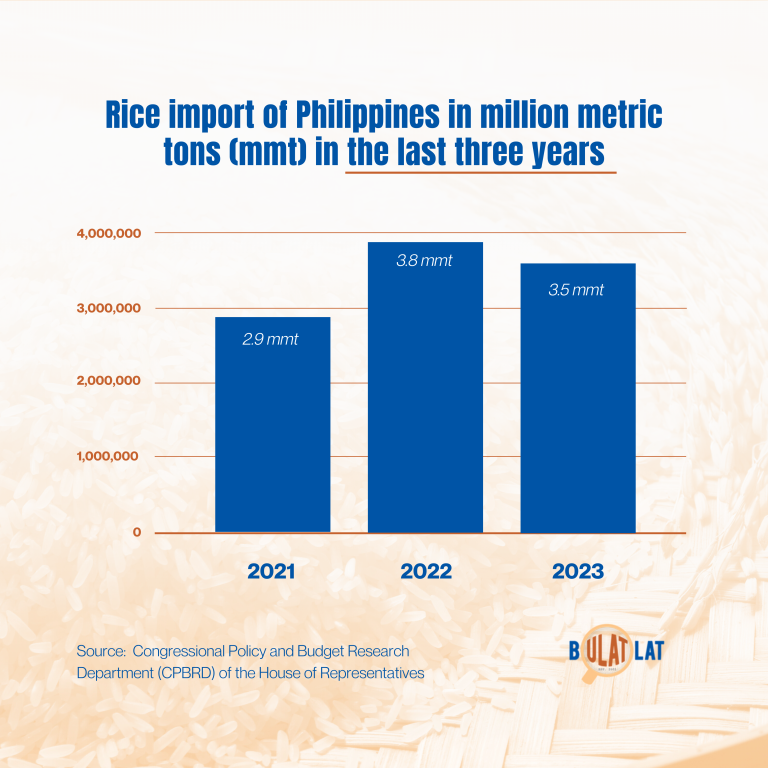Tags
Cheaper rice prices ‘unlikely’ as high-cost agri inputs remain a struggle for farmers

By FRANCK DICK ROSETE
CAGAYAN DE ORO – Filipinos still vividly remember the promise made by President Ferdinand Marcos, Jr., during his election campaign in 2022: to lower the prices of rice to P20 per kilo. However, after nearly three years, a rice farmer still sees it as something that is “unlikely to happen.”
This is because Marcos Jr. has no concrete plans to achieve what he vowed, Rolan Cagas, a rice farmer in Claveria, Misamis Oriental, told Bulatlat. “It would be hard for us,” he added when asked if they could lower the selling price of their produce.
He sells rice at P2,500 (US$124.57) per sack (50 kilograms), or P50 (US$2.49) per kilo.
Progressive group Kilusang Magbubukid ng Pilipinas (KMP) criticized the Marcos Jr. administration for its failure to reduce the prices of rice due to high rice importations. They also slammed his leadership for the alleged lack of support for local farmers.
“This administration’s patchwork policies have done nothing to solve the lingering rice crisis. Farmers are poorer, and consumers are paying more for rice,” said KMP National Chairperson Danilo Ramos in a statement. Ramos is vying for a seat in the Senate this 2025 elections to give voice to farmers.
High-cost fertilizers
Cagas, who also sits as president of the Claveria Federation of Rice Farmers Associations, shared that their top concern was the rising prices of farm inputs, especially fertilizers, as it would now cost over P1,800 per sack, higher than the less-than-P1,000 price in the past years.
They received fertilizer subsidies from the local government unit and the Department of Agriculture, but the release of this aid was allegedly delayed.
“Like now, we have still been following up on the fertilizer [subsidy], but we were already done harvesting. The [release of] subsidy did not concur with our needs,” said Cagas, emphasizing that selling their rice at cheaper prices would be a disadvantage for them given the high production cost.
It would be a huge help for the rice farmers, he stressed, if the fertilizer subsidies from the government would be released during months when they do land preparation prior to planting in order for them to save cost.
In previous interviews, Feliciano Sugtom, a corn farmer and president of the Besigan-Poblacion Farmers Association in Cagayan de Oro, also shared the same sentiment, saying his corn production has been reduced from 3,000 to 1,000 kilograms.This came after he also lessened the purchasing of fertilizers from 10 to only two sacks per hectare when the prices skyrocketed.
In 2022, Marcos had a meeting with then Trade and Industry Secretary Alfredo Pascual, and instructed the agency to provide plans to ensure affordable fertilizers to the farmers to boost their production. But nothing has changed, according to the farmers.
High rice imports
The Department of Agriculture said the rice imports before the end of 2024 may reach an all-time high of 4.7 million metric tons (MMT).
This is due to the impact of natural hazards on local palay production, as the Philippine Statistics Authority (PSA) projected a decrease in the estimated palay production from July to September this year by 11.9 percent, or 3.35 MMT, from its actual output of 3.80 MMT in the same period of 2023.
The KMP asserted that the current administration’s over-reliance on rice imports shows a lack of long-term solutions to the rice crisis.
“Instead of strengthening local rice production, the government is importing at record levels, further entrenching the country’s dependence on rice from Vietnam and Thailand. This is a betrayal of our farmers and the Filipino people,” Ramos said.

Government data showed that the country had rice imports of 3.8 MMT in 2022, which is higher than the 2.9 MMT in 2021 but lower than the 3.5 MMT in 2023. Last year, the Philippines was the world’s top rice importer. Meanwhile, Vietnam remained the top rice exporter to the Philippines, followed by Thailand.
Watchdog Bantay Bigas earlier pointed out that rice importation brought so much harm to local farmers’ livelihood, as they are forced to sell their palay harvest to private traders at cheaper prices just to compete with imported rice.
Repeal liberalization law
The KMP urged the current administration and the agriculture department to “stop their obsession with imports and adopt a farmer-first approach,” calling for a genuine land reform to solve the rice crisis.
One of their continuing demands is the repeal of the Rice Liberalization Law, which was enacted in 2019.
Read: As prices increase, farmers demand repeal of Rice Liberalization Law
Cathy Estavillo, Amihan secretary general and Bantay Bigas spokesperson, asserted that local farmers and consumers did not get any benefit from the law.
“Since it reduced the tariff from 35% to 15%, the Philippines has remained the world’s number one rice importer, the price of rice has not gone down, and the livelihoods of farmers continue to be devastated,” she said in a statement.
Research group IBON Foundation earlier reported that three years after the implementation of the law, the net returns of a rice farmer had decreased by 40.3 percent, or P13,296 (US$225.85), from their net returns of P32,976 (US$560.15) per hectare before the liberalization.
Moreover, the farmers group also demanded an increase in subsidies for farm inputs for farmers to have better yields, and compensation for damaged rice crops caused by natural hazards.
They also called on the government to strengthen the role of the National Food Authority in stabilizing prices and providing a guaranteed market to local farmers, urging the administration that local food production should be a national priority. (RTS, RVO)
https://www.bulatlat.com/2024/12/23/cheaper-rice-prices-unlikely-as-high-cost-agri-inputs-remain-a-struggle-for-farmers/Published Date: December 24, 2024






